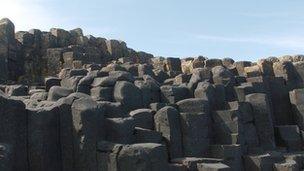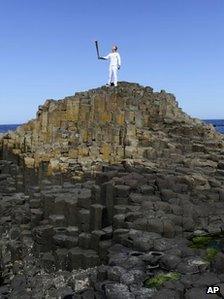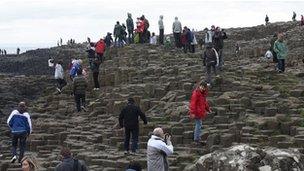Giant's Causeway's long history of attracting tourists
- Published

The Giant's Causeway has been a visitor attraction for centuries
The Giant's Causeway has been a local curiosity for as long as people have lived on the north Antrim coast.
Its hexagonal columns stretching out towards Scotland have attracted many myths and legends that are still passed on to the thousands of people who visit every year.
But the site was first revealed to the wider world in 1693 when Sir Richard Bulkeley, an Irish politician, gave a presentation to the Royal Society.
The great basalt structures caused much debate in scientific circles, with some claiming it was the work of man rather than nature.
Cutting edge
The Rev Dr Sam Foley, writing in 1694, described the rocks: "We found none square, but almost all pentagonal, or hexagonal; only a few had seven sides; and many more pentagons than hexagons; but they are all irregular… They always lie as close as possible for one stone to lie on another, so that on the outside of the pillars you can only discern the crack that joins the two stones."
In later years, the Causeway became a must-see attraction for wealthy Victorians touring Ireland.

Peter Jack holds the Olympic torch aloft at the Giant"s Causeway last month
By 1836 they could stay at the newly-built Causeway hotel. One way to get to the famous stones was the narrow-gauge railway line that runs from Bushmills.
Today tourist steam trains still use the line, but in the late 19th century cutting-edge technology operated on this line. It was the first to be powered by hydroelectricity.
Recognising the uniqueness of the area, the National Trust took over the management of the site in 1961.
Since then it has enabled millions of people to visit the stones, with its bus helping those less able to make the journey down the hill or back up. The site is also deemed an important ecological reserve and the trust has sought to manage and protect the flora and fauna found on this rugged section of coastline.
The Giant's Causeway was declared a World Heritage Site by Unesco in 1986. This means the area was deemed to be of such 'Outstanding Universal Value' that it is the responsibility of the international community as a whole to protect and conserve it.
While the stones have stood the test of time, the visitors centre has not.
Controversy
In 2000, it burned down and there followed years of controversy over what should replace it.

The Giant's Causeway remains a popular tourist attraction
In 2007, Northern Ireland's then environment minister Arlene Foster said she was minded to let property developer Seymour Sweeney's company, Seaport Investments Ltd, build the centre.
But this decision was reversed months later and it was Ms Foster's successor, Sammy Wilson, who gave the National Trust the go-ahead in 2009.
Construction work began in 2011 on the centre, described as "an illuminating exhibition showcasing the stories and the science behind the Giant's Causeway".
The building, which was designed to fit in to the surrounding landscape, has a grass roof which visitors will be able to walk on.
The structure has 186 black columns and basalt is, of course, the stone of choice. It is the very latest in energy efficient design - its carbon footprint is perhaps the only thing here which isn't 'giant'.
The rock formations may have once been relatively unknown, but they are now instantly recognisable across the globe - symbols of Northern Ireland's tourism offering.
- Published3 July 2012
- Published4 June 2012
- Published20 June 2011
- Published26 April 2012